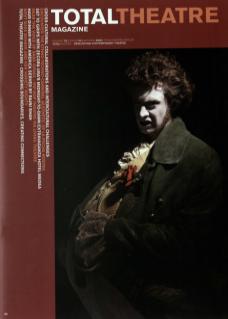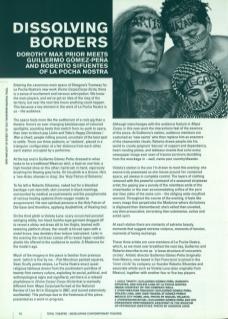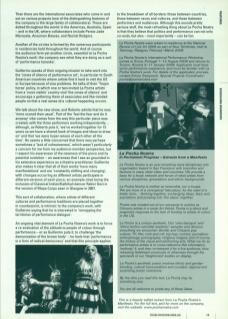Entering the cavernous main space of Glasgow's Tramway for La Pocha Nostra's new work Divino Corpo / Corpo Ilicito, there is a sense of excitement and nervous anticipation. We know the main players, and we've got an idea of the map of the territory, but over the next few hours anything could happen. This because a key element in the work of La Pocha Nostra is us – the audience.
The space feels more like the auditorium of a rock gig than a theatre: there's an ever-changing kaleidoscope of coloured spotlights; pounding beats that switch from nu-punk to opera, then later to kitsch pop (John and Yoko's Happy Christmas War is Over); people milling around, uncertain of the best spot to settle. There are three podiums, or 'stations', placed in a triangular configuration at a fair distance from each other, each station occupied by a performer.
At the top end is Guillermo Gómez-Peña; dressed in what looks to be a traditional Mexican skirt, a boot on one foot, a high-heeled shoe on the other, hairbrush in hand, vigorously brushing his flowing grey locks. On his plinth is a throne. He's a 'neo-Aztec shaman in drag', the 'Holy Patron of Bohemia'.
To his left is Roberto Sifuentes, naked but for a bloodied bandage-cum-loincloth, skin covered in black markings, surrounded by medical accoutrements and the paraphernalia of various healing systems (from oxygen masks to acupuncture). His neo-spiritual persona is the Holy Patron of Dis-Ease (and therefore, applying doublethink, of Healing too).
On the third plinth is Violeta Luna: scary scrunched ponytail swinging wildly, her black burkha-type garment dragged off to reveal a slinky red dress slit to her thighs, teamed with teetering platform shoes. Her mouth is forced open with a metal brace, less dentistry than torture instrument. Later in the evening the red dress comes off to reveal hyper-realistic plastic tits offered to the audience to suckle. A Madonna for the modern age.
Much of the imagery in the piece is familiar from previous work (which is fine by me) – Piet Mondrian painted squares, Sean Scully painted stripes, La Pocha Nostra enact quasi-religious tableaux drawn from the postmodern paintbox of twenty-first century culture, exploiting its social, political, and anthropological signs (and signifiers); yet there is a relaxed playfulness in Divino Corpo / Corpo Ilicito that is markedly different from Mapa Corpa (performed at the National Review of Live Art in Glasgow in 2007, and toured extensively worldwide). This perhaps due to the freshness of the piece, presented as a work-in-progress.
Although interchanges with the audience feature in Mapa Corpo, in this new work the interactions feel of the essence of the piece. At Guillermo's station, audience members are costumed as 'new saints' who then replace him as enactors of the shamanistic rituals. Roberto draws people into his world to create poignant 'dances' of support and dependency, heart-rending pietas, and tableaux vivants that echo every newspaper image ever seen of trauma survivors stumbling from the wreckage in – well, name your country/disaster.
Violeta's station is the one I'm drawn to most this evening: she seems truly possessed as she moves around her contained space, yet always in complete control. The layers of clothing removed with the powerful command of a seasoned striptease artist; the gaping jaw a parody of the relentless smile of the cheerleader or the ever-accommodating orifice of the porn star (two sides of the same coin – the obliging wide-mouthed woman). Throughout the course of the evening, it feels like every image that perpetrates the Madonna-whore dichotomy is displayed then dismembered: she's veiled then unveiled, coy then provocative, terrorising then submissive, active and acted upon.
At each station there are moments of extreme beauty, moments that suggest extreme violence, moments of tension, moments of loving exchange.
These three artists are core members of La Pocha Nostra, which, as we meet over breakfast the next day, Guillermo and Roberto describe to me as 'a loose structure of concentric circles'. Artistic director Guillermo Gómez-Peña (originally from Mexico, now based in San Francisco) is joined in the ‘inner circle' by company co-founder Roberto Sifuentes and associate artists such as Violeta Luna (also originally from Mexico), together with another four or five key players.
Then there are the international associates who come in and out on various projects (one of the distinguishing features of the company is the large family of collaborators). These are dotted throughout the world in the Americas, Australia, Spain – and in the UK, where collaborators include Persis-Jade Maravala, Ansuman Biswas, and Rachel Rodgers.
Another of the circles is formed by the numerous participants in residencies held throughout the world. And of course the audience form yet another circle, essential to La Pocha Nostra's work: the company see what they are doing as a sort of ‘performance karaoke'.
Guillermo speaks of their ongoing mission to take work into the 'zones of silence’ of performance art, in particular to South American countries where artists find it hard to visit the US or Europe because of visa problems. He talks of their ‘Trojan horse' policy, in which one or two invited La Pocha artists from a 'more visible' country visit the zones of silence and encourage a gathering there of associates and like-minded people so that a real sense of a cultural happening occurs.
We talk about the new show, and Roberto admits that he was 'more scared than usual'. Part of the 'feel the fear and do it anyway’ vibe comes from the way this particular piece was created, with the three performers working independently... although, as Roberto puts it, 'we've worked together for fifteen years so we have a shared bank of images and ideas to draw on' and that 'we were hyper-aware of each other all the time'. He seems a little concerned that there was perhaps sometimes a 'lack of cohesiveness', which wasn't particularly a concern for me from my audience-member perspective, but I respect his awareness of the newness of the piece and its potential evolution – an awareness that I see as grounded in his extensive experience as a theatre practitioner. Guillermo also makes it clear that all of their works 'have many manifestations’ and are ‘constantly shifting and changing’ with changes occurring as different artists participate in different versions of each piece, an example cited being the inclusion of Classical Indian/Kathikali dancer Rakini Devi in the version of Mapa Corpo seen in Glasgow in 2007.
This sort of collaboration, where artists of different cultures and performance traditions are placed together in counterpoint, is intrinsic to the company's work, with Guillermo saying that he is interested in 'remapping the territories of performance dialogue'.
An ongoing vital element of La Pocha Nostra's work is to force a re-evaluation of the attitude to people of colour through performance – or as Guillermo puts it, to challenge the demonisation of the brown body – he feels that performance is a form of radical democracy and that this principle applies to the breakdown of all borders: those between countries, those between races and cultures, and those between performers and audiences. Although this sounds pretty serious stuff, the most refreshing thing about La Pocha Nostra is that they believe that politics and performance can not only co-exist, but also – most importantly – can be fun.
La Pocha Nostra: In Permanent Progress – Extracts from a Manifesto
La Pocha Nostra is an ever morphing trans-disciplinary arts organisation based in San Francisco with branches and factions in many other cities and countries. We provide a base for a loose network and forum of rebel artists from various disciplines, generations and ethnic backgrounds.
La Pocha Nostra is neither an ensemble, nor a troupe. We are more of a conceptual laboratory for the want of a better term... thinking together, exchanging ideas, fears and aspirations and jumping into ‘the abyss' together.
Pocha was created out of our necessity to survive as Chicano artists in a racist Art World. Pocha is a direct and pragmatic response to the lack of funding to artists of colour in the US.
La Pocha is a unique aesthetic. Our 'robo-baroque' and 'ethno-techno cannibal aesthetic' samples and devours everything we encounter: Border and Chicano pop culture; TV; film; rock and roll; hip-hop, comics, journalism; anthropology; pornography, religious imagery and of course, the history of the visual and performing arts. What we do as performance artists is to cross-reference this information, 'embody' it, and then re-interpret it for a live audience, thus refracting fetishised constructs of otherness through the spectacle of our ‘heightened’ bodies on display.
La Pocha's aesthetic praxis involves ethnic and genderbending, cultural transvestitism and constant, atypical and surprising power inversions.
By the time you read this text, La Pocha may be something else.
You are all welcome to pirate any of these ideas.
La Pocha Nostra were artists-in-residence at the National Review of Live Art 2008 as part of New Territories, held at Tramway, Glasgow, February-March 2008.
La Pocha Nostra's International Performance Workshop comes to Evora, Portugal 1-12 August 2008 and returns to Tucson, Arizona 5-17 January 2009. Applicants must have some performance experience, and must be familiar with La Pocha Nostra's work. For details of the application process, contact Emma Tramposch, Special Projects Coordinator: pocha@pochanostra.com


